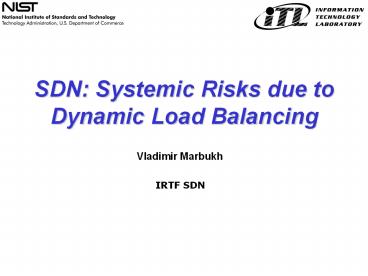SDN: Systemic Risks due to Dynamic Load Balancing - PowerPoint PPT Presentation
Title: SDN: Systemic Risks due to Dynamic Load Balancing
1
SDN Systemic Risks due to Dynamic Load Balancing
- Vladimir Marbukh
IRTF SDN
2
Abstract
SDN facilitates dynamic load balancing
- Systemic benefits of dynamic load balancing
- economic higher resource utilization, higher
revenue,.. - resilience/robustness to failures, demand
variability,..
- Systemic risks of dynamic load balancing
- robust to small yet fragile to large-scale
failures/overload - possibility of abrupt cascading overload
- persistent/metastable systemically congested
states
Necessity to manage SDN systemic risk/benefit
tradeoff
3
Congestion-aware Routing in a Delay Network
P. Echenique, J. Gomez-Gardenes, and Y. Moreno,
Dynamics of jamming transitions in complex
networks, 2004.
h1 congestion oblivious (minimum hop count)
routing
h0 congestion aware routing
Minimum-cost routing Route cost
hops from node i to the destination
queue length at node i
Congestion-aware routing robust to small yet
fragile to large-scale congestion Benefit lower
network congestion for medium exogenous load from
A1 to A2 Risk hard/severe network overload
(discontinuous phase transition) at A2 Economics
drives system to the stability boundary A2.
4
Congestion-aware Routing in Loss Network
Arriving request is routed directly if possible,
otherwise an available 2-link transit route.
Performance request loss rate L.
Positive feedback load increase ? more transit
routes ? load increase .. Cascading
overload
Combination of selfish requests variable demand
gt emergence of congested metastable (persistent)
state gt robust (to local) yet fragile (to
large-scale congestion)
Fully connected network
Loss under mean-field approximation F. Kelly
Metastability/Cascading overload F. Kelly
5
Cloud with Dynamic Load Balancing
Server group operational with
prob. non-operational with prob.
Failures/recoveries on much slower time scale
than job arrivals/departures
Static load balancing is possible if
and
where utilization is
Problems exogenous load uncertain,
other uncertainties. Possible solution dynamic
load balancing based on dynamic utilization,
e.g., numbers of occupied servers, queue sizes,
etc.
Problem serving non-native requests is less
efficient
and according to A.L. Stolyar and E. Yudovina
(2013) this may cause instability of natural
dynamic load balancing
6
Dynamic Load Balancing in Cloud V. Marbukh, 2014
- As level of resource sharing exceeds certain
threshold, metastable/persistent congested
equilibrium emerges, making Cloud robust to local
overload yet fragile to large-scale overload - With further increase in resource sharing,
performance of the normal metastable equilibrium
improves, while of the congested metastable
equilibrium worsens.
Figure. Lost revenue vs. exogenous load for
different levels of resource sharing
- Economics of the normal equilibrium drives
Cloud from robust to fragile and eventually to
stability boundary of the normal equilibrium. - This creates inherent tradeoff between lost
revenue - and systemic risk of large scale overload
Figure. Provider perspective lost revenue vs.
resource sharing level.
7
Systemic Performance/Risk Tradeoff in Cloud
Implication Uncertainty makes systemic
Risk/Performance tradeoff essential
Figure. Risk/Performance tradeoff
Question How can one-dimensional analysis
describe a heterogeneous Cloud? Answer
Perron-Frobenius theory due to congestion
dynamics being non-negative
Since normal equilibrium loses stability as
Perron-Frobenius eigenvalue of the linearized
system crosses point from
below, it is natural to quantify the system
stability margin and risk of cascading overload
by
Word of caution the above results are obtain
under mean-field approximation.
8
Future Research
- Verification/validation results obtained under
mean-field approximation through simulations,
measurements on networks and rigorous analysis
(doubtful). - Possibility of online measurement of the
Perron-Frobenius eigenvalue for the purpose of
using it as a basis for early warning system. - Possibility of controlling networks, especially
through pricing, based on the Perron-Frobenius
eigenvalue.
9
Thank you!































